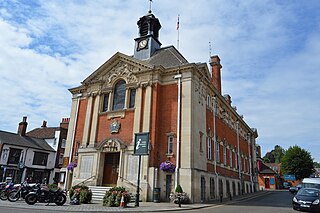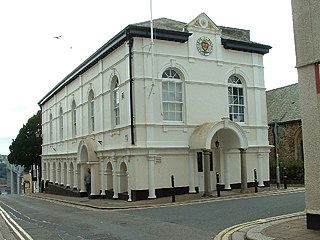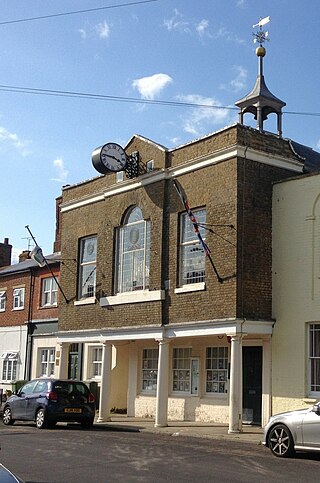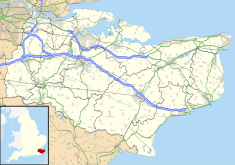In the United Kingdom and Republic of Ireland, a county town is the most important town or city in a county. It is usually the location of administrative or judicial functions within a county, and the place where the county's members of Parliament are elected. Following the establishment of county councils in England 1889, the headquarters of the new councils were usually established in the county town of each county; however, the concept of a county town pre-dates these councils.

Lydd is a town and electoral ward in Kent, England, lying on Romney Marsh. It is one of the larger settlements on the marsh, and the most southerly town in Kent. Lydd reached the height of its prosperity during the 13th century, when it was a corporate member of the Cinque Ports, a "limb" of Romney. Actually located on Denge Marsh, Lydd was one of the first sandy islands to form as the bay evolved into what is now called Romney Marsh.

Cowbridge Town Hall is a public building in the High Street of Cowbridge in South Wales. The town hall, which is the meeting place for Cowbridge with Llanblethian Town Council, and also houses the town clerk's office, the committee rooms and the Cowbridge Museum, is a Grade II* listed building.
Irene Bass Sutton Wellington (1904–1984) was an influential British calligrapher and teacher of calligraphy.

Maidstone Town Hall is a municipal building in Middle Row, Maidstone, Kent, England. The town hall, which is a meeting place of Maidstone Borough Council, is a Grade II* listed building.

Folkestone Town Hall, also known as The Guildhall, is a municipal building in Guildhall Street, Folkestone, Kent, England. The town hall, which was the headquarters of Folkestone Borough Council, before it was converted to house the Folkstone Museum. It is a Grade II listed building.

Henley Town Hall is a municipal structure in the Market Place in Henley-on-Thames, Oxfordshire, England. The town hall, which is the headquarters of Henley Town Council, is a Grade II* listed building.

Saltash Guildhall is a municipal building in Fore Street, Saltash, Cornwall, England. The structure, which was the meeting place of Saltash Borough Council, is a Grade II listed building.

Fordwich Town Hall is a municipal structure in King Street, Fordwich, Kent, England. The structure, which serves as the meeting place of Fordwich Town Council, is a Grade II* listed building.

Queenborough Guildhall is a former municipal building in the High Street in Queenborough, Kent, England. The structure, which is currently used as a museum, is a Grade II listed building.

The Guildhall is a municipal building in Fore Street in Plympton, Devon, England. The structure, which is used as a community events venue, is a Grade II* listed building.

Lostwithiel Guildhall is a municipal building in Fore Street in Lostwithiel, Cornwall, England. The structure, which currently accommodates the local museum, is a Grade II listed building.

Looe Guildhall is a municipal building in Fore Street in Looe, Cornwall, England. The structure, which is currently used as a community events venue, is a Grade II listed building.

The Old Guildhall is a municipal building in Higher Market Street in Looe, Cornwall, England. The structure, which is currently used as a museum, is a Grade II* listed building.

Ilchester Town Hall is a municipal building in the High Street in Ilchester, Somerset, England. The structure, which serves as the offices and meeting place of Ilchester Town Council, is a Grade II listed building.

The Old Town Hall is a municipal building in South Street in Seaford, East Sussex, England. The structure, which is used as a community tea room, is a Grade II listed building.

Winchelsea Court Hall, formerly known as the Water Bailiff's Prison, is a municipal building in the High Street in Winchelsea, East Sussex, England. The structure, which is used as a museum, is a Grade I listed building.

Bradninch Guildhall is a municipal building in Fore Street, Bradninch, Devon, England. The structure, which is now used as a community events venue, is a Grade II listed building.

The Old Town Hall is a municipal building in the Market Place, Great Dunmow, Essex, England. The structure, which is now used as the offices of a firm of estate agents, is a Grade II listed building.

Llantrisant Guildhall is a municipal building on Castle Green, Llantrisant, Rhondda Cynon Taf, Wales. The structure, which is used as a visitor centre, is a Grade II listed building.



















